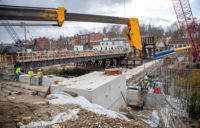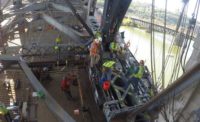Because the project lies on the priority Trans-European Network Corridor lV, from Berlin to southeastern Europe, it also qualified for EU support.
The EU, France and Germany are providing three-quarters of the bridge's current $290-million budget in grants and loans, while Bulgaria is paying the balance. With construction claims still under negotiation, the final cost has yet to be announced.
To procure the project, the Bulgarian government provided reference designs but allowed bidders to offer their own ideas. Major contractors from France and Germany also put in bids for the design-build contract, but FCC won it in January 2007.
Working with Madrid-based Carlos Fernandez Casado S.L., FCC “integrated the railway and the highway in the same bridge,” says Díaz de Argote. “In the tender documents, there were two bridges.”
The contractor also adopted a cable-supported, “extradosed” type of structure. With the pylons rising only some 21 m above the roadway, stay cables are set at shallow angle, providing some uplift but also acting as external prestressing for the deck girder.
FCC and its prestressing subcontractor, BBR PTE S.A., Madrid, also eliminated the conventional steelwork tower top. Instead, on either side of each pylon, cables are fixed to anchorages, which are tied together with prestressing.
Eliminating cable saddles will ease future inspection and maintenance, says High-Point Rendel's Jones.
FCC erected the main bridge using glued segmental match-cast deck-girder sections. The contractor cast over 450 deck pieces, each weighing up to 250 tonnes, near Vidim.
The deck has a roughly 7.3-m-wide x 4.5-m-deep box-girder spine with side walls up to 1.3 m thick. The girder's top slab extends outward to form the 31.5-m-wide deck. From either side of the girder's base, concrete struts rise at an angle to support the deck slab some 4.4 m from its outer edges.
Apart from the bureaucratic snags, the construction team had to deal with temperatures ranging from -20 to +40 degrees Celsius, says Jones. Crews also worked around an average of 100 large barges crossing through every week.
Seasonal variations in the water were a challenge when they exceeded eight meters, especially while boring the bridge's 2-m-dia, 80-m-long piles, notes Díaz de Argote.









Post a comment to this article
Report Abusive Comment